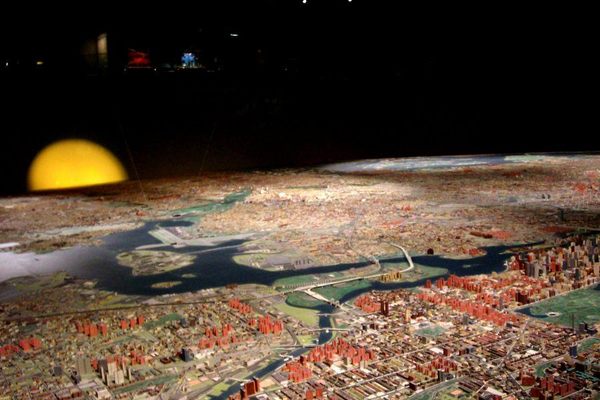Relics of the World’s Fair: Chicago
The 1893 Chicago World’s Fair (via Boston Public Library)
From exploring what remains of the World’s Fair in Paris, we continue in our World’s Fair series by looking at what survives from the fairs in Chicago. The Windy City sports relics from just two World’s Fairs — compared to the six in Paris — but they’re two of the most famous fairs in history, with many relics.
CHICAGO: Host to two World’s Fairs — 1893 and 1933
“Captive” balloon and the ferris wheel at the World’s Columbian Exposition (1892-1893) (photograph by Charles Dudley Arnold, via the J. Paul Getty Museum)
Chicago’s 1893 World’s Columbian Exposition was particularly successful — and famous — thanks in part to a staggering array of cultural and technological marvels which debuted there, including some of the first demonstrations of electrical power, the world’s first Ferris Wheel, and the first servings of the candied popcorn that would later be dubbed “Cracker Jacks.” Nearly all the halls and pavilions at the fair were temporary, but a handful of buildings still stand — although not all of them are still in Chicago.
A mammoth and giant octopus model in 1893 at the World’s Fair (via the Field Museum)
The fair’s Palace of Fine Arts, located in today’s Jackson Park neighborhood, housed over 10,000 artistic works from around the world; mostly oil paintings from across the United States and throughout Europe. But natural history displays caught the public’s attention more, and the Palace of Fine Arts became the “Columbian Museum” after the fair, created to give these exhibitions a permanent home.
In 1905, department store magnate Marshall Field became the museum’s first big benefactor, and the Columbian Museum re-christened itself the Field Museum. The museum also changed its location — in 1920, it moved to a new location nearer the downtown Loop business district, leaving the Palace of Fine Arts empty. A new science museum moved in — the Museum of Science and Industry, which opened just in time for the 1933 World’s Fair.
The Palace of Fine Arts in 1893 (via Project Gutenberg)
The Palace of Fine Arts today, now the Museum of Science and Industry (photograph by Allison Meier/Atlas Obscura)
The Field Museum relocated from one building to another — but in the case of another 1893 fair structure, the building itself moved. The Norway Building, constructed for Norway’s exhibits, caught the fancy of Chicago businessman C.K.G. Billings, who bought the structure outright at fair’s end and shipped it to his vacation estate in Wisconsin, where it became his summer home.
After Billings’ death, ownership of the Norway Building passed through several hands until the 1930s, when another Norwegian-born Chicago businessman founded “Little Norway,” a living-history recreation of an old Norwegian village. Little Norway’s founder, Isak Dahle, purchased the Norway Building and moved it permanently to Blue Mounds, Wisconsin, where it sits today.
The Norway Building at Little Norway, Wisconsin (photograph by Clarissa Peterson)
Another piece of Norway’s exhibition is elsewhere in Illinois. In 1880, Norwegian archaeologists excavated a burial mound and discovered a complete 9th Century Viking ship, and were understandably keen to show it off — but reluctant to part with the real thing. Instead, Norwegian shipbuilders constructed a replica they called simply The Viking, and a crew of eleven men actually sailed it from Norway to Chicago.
After the Fair, The Viking stayed docked just nearby the (now former) Field Museum, then was temporarily moved to New Orleans before relocating to a wooden shed in Chicago’s Lincoln Park in 1919. Then in the 1990s, the Lincoln Park Zoo sought an expansion and evicted The Viking again. The Museum of Science and Industry claimed the head and tail of the ship, although both pieces are kept in storage. A non-profit group claimed the rest, moving the ship to Geneva, Illinois, where they currently offer tours of The Viking and work towards finding it a more permanent home.
A replica of the Gokstad viking ship in 1893 at the World’s Fair (via Wikimedia)
Some of the landmarks from the 1933 fair were also relocated. The 1933 Fair, dubbed the “Century of Progress” fair, was designed to feature upcoming innovations in architecture, science, and technology. Among the exhibits were a series of “Homes of the Future” — model homes meant to show off different design or technological innovations, such as a private airplane hangar, novel construction materials, and the like. After the fair ended, developer Robert Bartlett bought five of the model homes for a planned community in Beverly Shores, Indiana. The five houses didn’t attract customers initially — some of the “innovations” from the 1930s proved to be liabilities only 20 years later.
Then in the 1970s, the National Parks service included the five homes as part of the Indiana Dunes National Park, and began repairing and restoring the houses. The state of Indiana also offered househunters a unique chance to lease the homes as their own residence, in exchange for serving as live-in caretakers. The homes are used as residences today, but occasionally open to the public for tours.
The Florida model home at the 1933 A Century of Progress fair (via UIC Digital Collections)
The Florida Century of Progress home today at Indiana Dunes (via Indiana Dunes)
Here are more images of the World’s Fair in Chicago:
The Court of Honor (1893) (via Brooklyn Museum)
Columbian Fountain (1893) (via Brooklyn Museum)
The Agricultural Building (1893) (via Brooklyn Museum)
The Liberal Arts Building (1893) (via Brooklyn Museum)
Visitors eating lunch in 1893 (via Smithsonian Institution Archives)
Ferris wheel view in 1893 (via Brooklyn Museum)
The Fisheries Colonnade (1893) (via Brooklyn Museum)
The Ferris Wheel in 1893 (via the New York Times)
A replica of one of the ships sailed by Columbus (1893) (via Smithsonian Institution Archives)
Fire Boat and Agricultural Building, with a fire department boat shooting water cannons (1893) (via the Field Museum)
A day in 1893 at the World’s Fair (via Smithsonian Institution Archives)
The Grand Basin at night (1893) (via Brooklyn Museum)
Stay tuned for more in our series on World’s Fair relics, and click here to revisit Paris.









Follow us on Twitter to get the latest on the world's hidden wonders.
Like us on Facebook to get the latest on the world's hidden wonders.
Follow us on Twitter Like us on Facebook